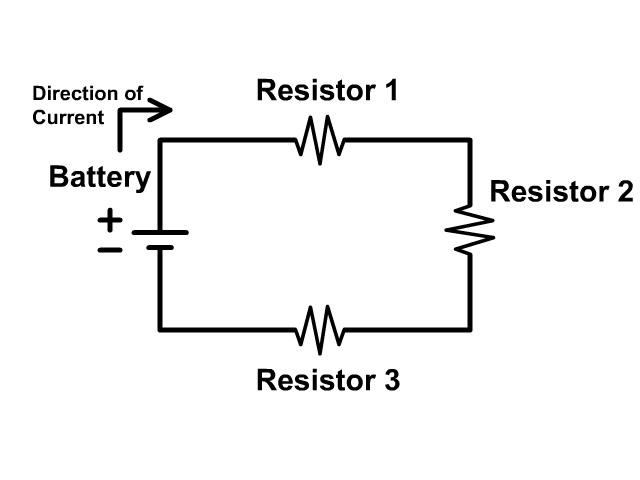What are the charges of protons and electrons, respectively?
Positive and negative
Which charges are actually moving through an electric current?
Negative charges (electrons)
What is Ohm's law?
V=IR
Series or parallel?

Series
What is static electricity?
An imbalance of electric charge on an object
Which direction is current drawn flowing in a circuit diagram and why?
It is drawn flowing from the positive to negative side and it's because people didn't know that was wrong initially and then didn't want to change it because negative signs are a pain and people are lazy.
What 3 quantities are involved in Ohm's law and what are their units?
Volts (potential energy of power source) - unit is volts, V
Current (amount of charge per second) - unit is Amps, A
Resistance (the material's resistance to letting charge flow through it) - unit is ohms, 
What is it called when you connect an object to another relatively massive and neutrally charged object?
Grounding
Describe one way an object could acquire static electricity.
Friction: rubbing a cloth over a glass rod could attract the glass' valence electrons onto the cloth, giving the cloth a negative charge and the rod a positive charge
Induction: Brining a charged object close to a neutral object can polarize the neutral object. Then if you cut the object in half, both halves would have a net charge.
Grounding: Bringing a negatively charged object close to a grounded object would cause the valence electrons in the grounded object to move into the ground, making the object positively charged.
What type of circuit is pictured above?
Parallel circuit. You can tell because the wires branch
Given that a circuit has a current of 2 A and a resistance of 0.5  , what is the voltage of the power source to this circuit?
, what is the voltage of the power source to this circuit?
1 Volt
How does a fuse protect your house?
The fuse has a fragile wire that will break whenever too much current tries to flow through it (disconnecting the power source from the rest of your house). This prevents your appliances from drawing too much current and starting a fire.
What is lightning and how does it work?
Lightning is static discharge within a cloud, which can connect with the ground. Lightning is caused when friction within a cloud causes an uneven distribution of charge, which creates an electrical field. This electrical field attracts the opposite charge on the ground (or from another location in the cloud). The charges ionize the air, forming a connective pathway that allows them to flow together.
Draw a simple series current with three resistors and a battery, using standard symbols.

What is the current across a circuit that is powered by a 12-V battery and has a resistance of 200 m𝝮?
Remember that 1000 m𝝮 = 1 𝝮
Unit Conversion:
200 m𝝮 * (1 𝝮/1000m𝝮) = 0.2 𝝮
Calculate I:
V=IR divide both sides by R and you get
V/R = I
12/0.2 = 60 A
What materials allow for the flow of electrons? What materials resist the flow of electrons?
Conductors and insulators
Describe what causes the appearance, sound, and smell of static discharge.
A strong electric field generated by static electricity ionizes the air molecules (turns them to plasma). The ionized gas emits bluish purple light as it allows the charges to flow through it. The superheated air rushes outwards, creating a cracking sound. As it cools, it reforms into a gas, some of which binds into O3, ozone, instead of oxygen gas, O2. Ozone has a sharp smell, kind of like chlorine
Which circuit would have brighter light bulbs, series or parallel? Which circuit could work even if a light bulb burns out? Why?
Parallel and parallel
In parallel, the current is not as restricted, so resistance is lower than in series, raising the amps. When a light bulb burns out, it disconnects that circuit, but in parallel, there are other paths that still connect to the battery and keep the current flowing.
Given that 1 k𝝮 = 1,000 𝝮
and that 1,000,000 𝜇A = 1 A
What is the voltage powering a 4390 𝜇A current with a resistance of 1.71 k𝝮?
Unit Conversion:
1.71 k𝝮 * (1000 𝝮/1k𝝮) = 1710 𝝮 = R
4390 𝜇A * (1 A/1,000,000 𝜇A) = 0.00439 A = I
Calculate V:
V=IR= (0.00439 A)*(1710 𝝮) = 7.51 V
Using Ohm's Law, explain why you shouldn't remove all resistors from a circuit, only connecting the battery terminals with wire that has very, very small resistance.
V=IR, so if Voltage is constant (a constant source from the battery) and resistance drops to almost zero, current has to become massive. To demonstrate this, imagine a 6-Volt battery's terminals are connected by a wire that has 1 𝜇𝝮 resistance. Solving for I would yield 6,000,000 Amps! That would correspond to 375,000,000,000,000,000,000,000,000 electrons flowing past per second, which is too much for the circuit to handle and would start a fire.
